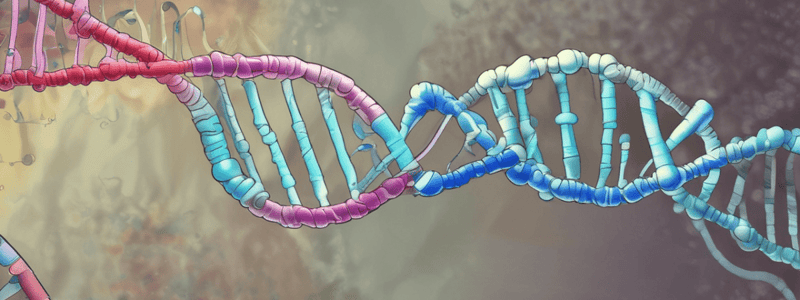Podcast
Questions and Answers
What is the primary cause of spontaneous mutations in DNA?
What is the primary cause of spontaneous mutations in DNA?
- DNA replication errors
- Genetic events such as recombination
- Chemical instability of DNA components (correct)
- Environmental factors such as UV radiation
What is the role of p50 protein in the DNA repair mechanism?
What is the role of p50 protein in the DNA repair mechanism?
- Coordinating response between cell cycle and DNA repair
- Detecting DNA damage
- Inducing apoptosis in damaged cells
- Ensuring damaged DNA and proteins are not replicated (correct)
What is the difference between apoptosis and necrosis?
What is the difference between apoptosis and necrosis?
- Apoptosis is a result of DNA repair, while necrosis is a result of DNA damage
- Apoptosis is programmed cell death, while necrosis is caused by physical destruction (correct)
- Apoptosis is caused by physical destruction, while necrosis is programmed cell death
- Apoptosis is a result of DNA damage, while necrosis is a result of DNA repair
What is the ultimate consequence of DNA damage that is not repaired?
What is the ultimate consequence of DNA damage that is not repaired?
What is the primary mechanism of DNA repair that corrects mismatches in DNA?
What is the primary mechanism of DNA repair that corrects mismatches in DNA?
What is the result of unrepaired DNA damage?
What is the result of unrepaired DNA damage?
What is the role of DNA repair in maintaining genome integrity?
What is the role of DNA repair in maintaining genome integrity?
What is the consequence of DNA replication errors?
What is the consequence of DNA replication errors?
What is the primary function of DNA glycosylases in base excision repair?
What is the primary function of DNA glycosylases in base excision repair?
What is the result of non-homologous end joining repair?
What is the result of non-homologous end joining repair?
What is the purpose of DNA ligase in nucleotide excision repair?
What is the purpose of DNA ligase in nucleotide excision repair?
What is the role of DNA polymerases in nucleotide excision repair?
What is the role of DNA polymerases in nucleotide excision repair?
What is the primary function of DNA mismatch repair?
What is the primary function of DNA mismatch repair?
What is the result of AP site formation in base excision repair?
What is the result of AP site formation in base excision repair?
What is the characteristic of non-homologous end joining repair?
What is the characteristic of non-homologous end joining repair?
What is the consequence of non-homologous end joining repair?
What is the consequence of non-homologous end joining repair?
What type of DNA damage occurs when benzo[a]pyrene leads to insertion and covalent bond formation between the molecule and DNA?
What type of DNA damage occurs when benzo[a]pyrene leads to insertion and covalent bond formation between the molecule and DNA?
Which type of DNA damage is characterized by defects in both DNA strands?
Which type of DNA damage is characterized by defects in both DNA strands?
Which DNA repair pathway takes advantage of the double-stranded nature of the DNA molecule?
Which DNA repair pathway takes advantage of the double-stranded nature of the DNA molecule?
What is the primary function of photolyase enzyme in DNA repair?
What is the primary function of photolyase enzyme in DNA repair?
Which type of DNA damage is not a direct result of ionizing radiation?
Which type of DNA damage is not a direct result of ionizing radiation?
What is the general term for the repair of DNA backbone defects?
What is the general term for the repair of DNA backbone defects?
Flashcards are hidden until you start studying
Study Notes
Nucleotide Excision Repair
- Damage is detected by an enzyme, which leaves the undamaged DNA intact.
- DNA polymerases use the intact DNA as a template to synthesize a short complementary sequence.
- DNA ligase then joins the two strands to form a double-stranded nature.
Base Excision Repair
- Removes damaged bases that could cause mutations.
- Initiated by DNA glycosylases, which recognize and remove specific damaged or inappropriate bases.
- AP sites are formed, where polymerase binds to synthesize nucleotides.
DNA Mismatch Repair
- Recognizes and repairs insertion, deletion, and mis-incorporation of bases that occur during DNA replication.
- System for correcting errors that occur during DNA replication.
Non-Homologous End Joining Repair
- Repairs DNA by joining broken ends of the chromosome without a template.
- Enzymes bind and weld DNA pieces together, removing damaged or mismatched nucleotides with nucleases and resynthesizing with DNA polymerases.
- Can result in loss or addition of a few nucleotides at the cut site and often leads to mutations.
Mutations
- A randomly derived change to the nucleotide sequence of an organism's genetic material, causing a biological effect.
- 3 main causes: spontaneous, environmental, and genetic events.
Importance of DNA Repair
- DNA is the only biological macromolecule that is repaired, while others are replaced.
P50 Repair Mechanism
- Damage is detected, increasing p50 protein in the cell.
- Ensures damaged DNA and proteins are not replicated.
- p50 induces genes, leading to apoptosis and coordinating response between cell cycle and DNA repair.
Apoptosis vs Necrosis
- Apoptosis: programmed cell death, outer membrane remains intact and functional.
- Necrosis: caused by physical destruction to the cell membrane, leading to cell destruction.
Ionising Radiation Effects
- Causes single-strand breaks, double-strand breaks, base damage, and crosslinks.
DNA Repair Types
- 3 main types: direct reversal of damage, excision, and strand break repair.
- Examples: photoreactivation (direct reversal), nucleotide excision repair and base excision repair (excision), and non-homologous end joining repair (strand break repair).
Studying That Suits You
Use AI to generate personalized quizzes and flashcards to suit your learning preferences.



